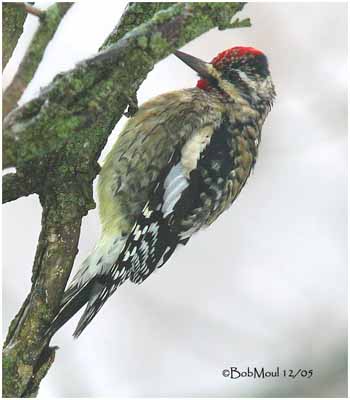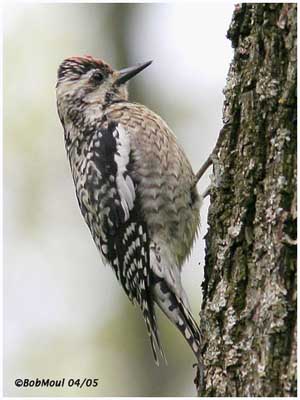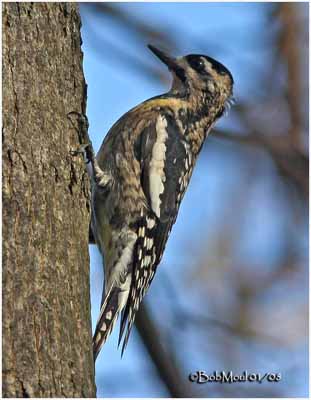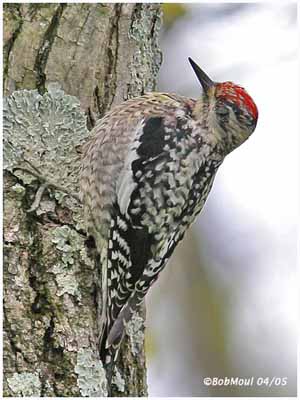
Yellow-bellied Sapsucker
Sphyrapicus varius
Piciforme Order – Picidae Family
BIOMETRICS:
Length: 18 à 22 cm
Wingspan: 34 à 40 cm
Weight: 43 à 55 g
LONGIVITY: Up to 6 years
DESCRIPTION:
Yellow-bellied Sapsucker is a medium-sized woodpecker.
DIET:
Yellow-bellied Sapsucker feeds on insects. Most common are beetles, ants, moths and dragonflies. When insects are not abundant, sap is an important food source.
During autumn and winter, it feeds on berries and fruits. Frequently, the bird may adopt a tree, and feeds on it year after year, especially birches.
PROTECTION / THREATS / STATUS:
Yellow-bellied Sapsucker have probably benefited with destruction of mature forests, and creation of forest gaps and increase edges. Populations appear stable.
Fr: Pic maculé
All: Gelbbauch-Saftlecker
Esp: Chupasavia Norteño
Ital: Picchio ventregiallo
Nd: Geelbuiksapspecht
Russe: Желтоклювый дятел-сосун
Sd: Gulbröstad savspett
Photographs by Bob Moul
His website: Nature Photography
Text by Nicole Bouglouan
Sources:
HANDBOOK OF THE BIRDS OF THE WORLD Vol. 7 by Josep del Hoyo-Andrew Elliott-Jordi Sargatal – Lynx Edicions – ISBN: 8487334377
FIELD GUIDE TO THE BIRDS OF NORTH AMERICA by National Geographic Society - National Geographic Society - ISBN: 0792274512
All About Birds (Cornell Lab of Ornithology)
Animal Diversity Web (University of Michigan Museum of Zoology)
What Bird-The ultimate Bird Guide (Mitchell Waite)
Wikipedia (Wikipedia, The Free Encyclopedia)

Yellow-bellied Sapsucker is a medium-sized woodpecker.
Adult male has a red forehead, black and white head and red throat. Back is blackish, with a white rump, and a large white wing patch. Underparts are yellowish. Wings are black with white spotting. Tail is barred black and white, black on sides.
Eyes are black. Bill, legs and feet are blackish.

Female looks similar, but has white throat and paler underparts. Red on crown is less extensive, or even entirely black.

Juvenile has mottled brownish head, breast and upperparts down to back. Mantle, scapulars and back are dark brown with whitish feathers fringes.
VOICE: SOUNDS BY XENO-CANTO
Yellow-bellied Sapsucker’s most frequent call is a slurred, nasal, cat-like mewing “me-ah”, falling in pitch. Drumming consist of a rapid series of strikes followed by several spaced-out taps. Breeding call is a “kwee-urk” which is also a territorial call. “Quirks” is used between mates. “Week, week-wurp-wurp” are exchanged between pairs and/or their juveniles.
HABITAT:
In natural range, Yellow-bellied Sapsucker is found in forests, woodlands, groves and orchards. It breeds in young forests and along streams. It winters in variety of forests, especially semi-open woods.
RANGE:
Yellow-bellied Sapsucker breeds from Central Alaska to Newfoundland, and southwards to S Alberta, N Iowa, Pennsylvania, and southwards in Appalachians to N Carolina.
It winters in south-eastern quarter of the United States, southwards to Panama and West Indies.
BEHAVIOUR:
Yellow-bellied Sapsucker forages for insects by gleaning, probing, prying, tapping and flycatching. It flacks off bark chips or excavates insects in dead wood. It drills series of shallow holes in the bark, to lick up sap. It makes two kinds of holes: round deep and narrow holes where it inserts its bill to probe to sap; rectangular shallower holes which maintain continually for the sap to flow and attract insects. New holes are made in a line with old holes, or in a new line above the previous.

Yellow-bellied Sapsucker uses human structures to help in its territorial drumming. It seems to suffer no ill effects of whacking its bill on metal, the bird returns to it day after day.
Yellow-bellied Sapsucker is a migratory bird. Females tend to migrate farther south than do males.
Courtship displays are performed at the site of excavation. During these flights, we can hear a “winnowing” sound. Other ritual consists of tapping to strengthen pair bonds: male taps on a tree and female responds with a similar tap. To attract a potential mate, male and female raise the head to show their throats patches, red for male and white for female. They raise their crest and shake their head to display aggression.
Yellow-bellied Sapsucker may hybridize with Red-napped sapsucker.
Unfortunately, Yellow-bellied Sapsucker holes damage trees, and sometimes provides points of entry for fungus and other diseases.
FLIGHT:
Yellow-bellied Sapsucker has a gently undulating flight.
REPRODUCTION:
In late April and May, nest is excavated in live birch and poplar trees at about 2 to 20 metres above the ground. Both adults share this work.

Female lays 4 to 7 white eggs. Incubation lasts about 12 to 13 days, by both parents. Male spends more time on the eggs, especially at night. Chicks hatch naked and helpless.
Young fledge when they are 25 to 29 days old. Parents must feed them nine times per hour.
To help in sanitation, adults mix sawdust with dropping and carry them out of the nest.